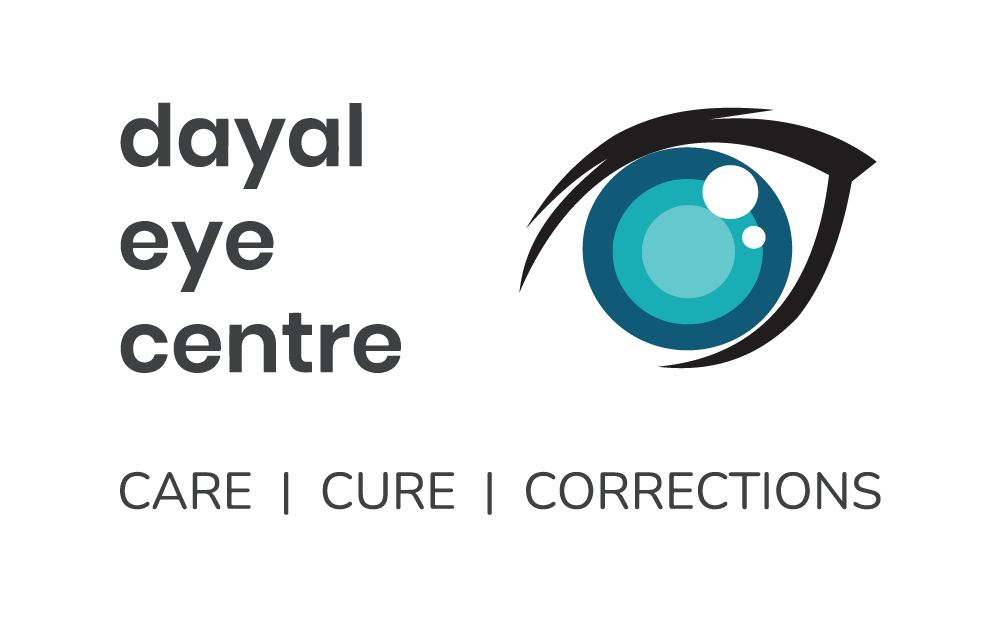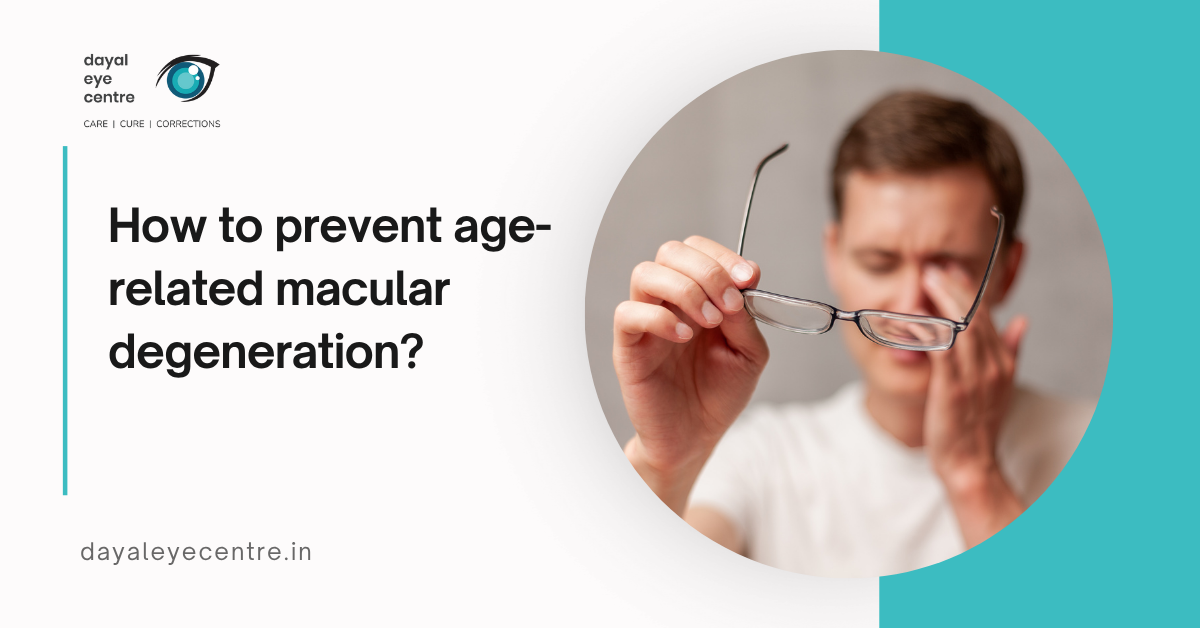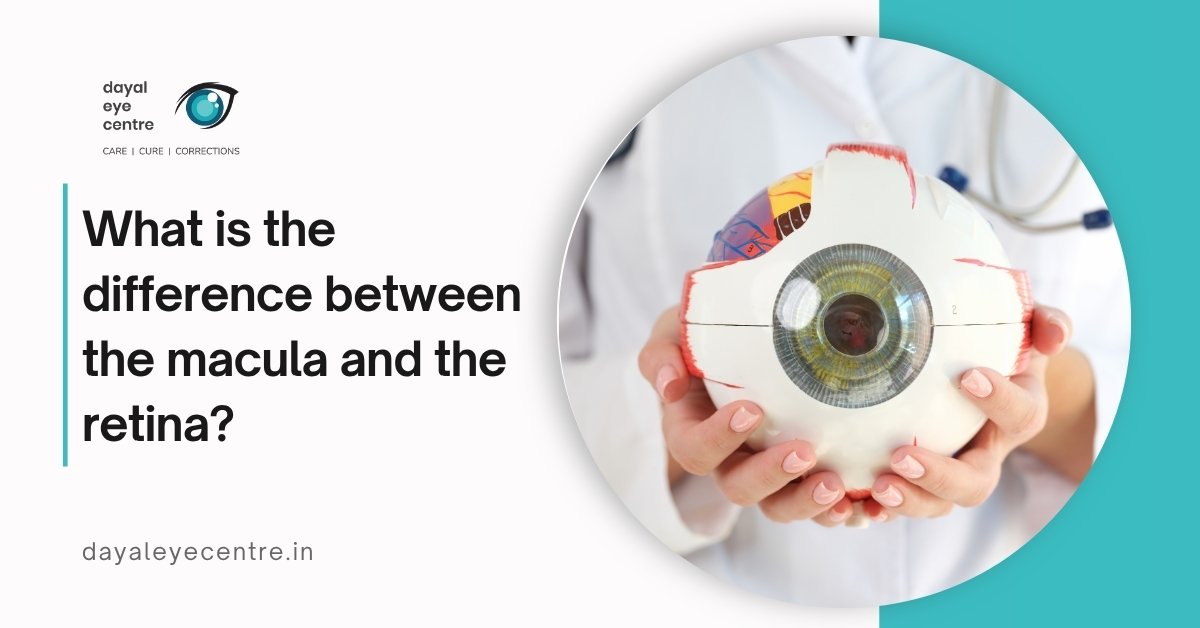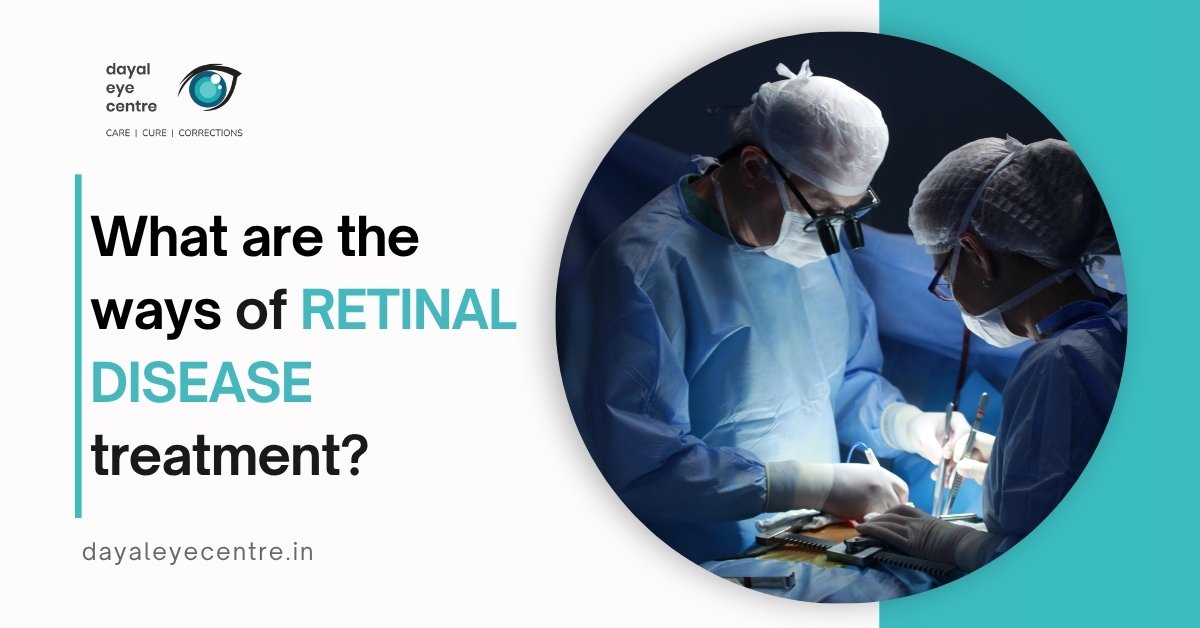Presbyopia is a natural, age-related vision condition that affects everyone as they get older. The term comes from Greek words meaning “aging eye,” which perfectly describes what happens as this condition develops. This isn’t a disease but a normal part of the aging process that typically begins around age 45.
How the eye normally focuses
Your eyes’ natural focusing process helps explain presbyopia. Light enters your eye through the pupil and reaches the lens first. A circular muscle (called the ciliary muscle) attaches to the lens by fine fibers. This muscle plays a vital role to change your lens’s shape, which lets you focus on objects at different distances.
The ciliary muscle tightens when you look at nearby objects. This makes the lens curve and thicken. The process, known as accommodation, helps the eye focus light onto the retina to create a sharp image. The muscle relaxes and the lens becomes flatter and thinner when you look at distant objects.
Doctors measure your lens’s focusing power, technically called refractive power, in diopters (D). They use this same unit to describe corrective eyewear strength.
What changes with age
Molecular changes inside our lenses make them harder and less flexible as we age. The natural hardening means your lens can’t curve and thicken easily when looking at close objects. Your eyes’ ability to change focus—or accommodate—gradually decreases.
People start noticing presbyopia’s effects in their early to mid-40s. You might find yourself holding books farther away to see them clearly. These focusing problems become more noticeable, especially when you have to read small print or work in dim light.
Vision changes continue until around age 60. After that, near vision tends to stabilize and prescription changes happen less often.
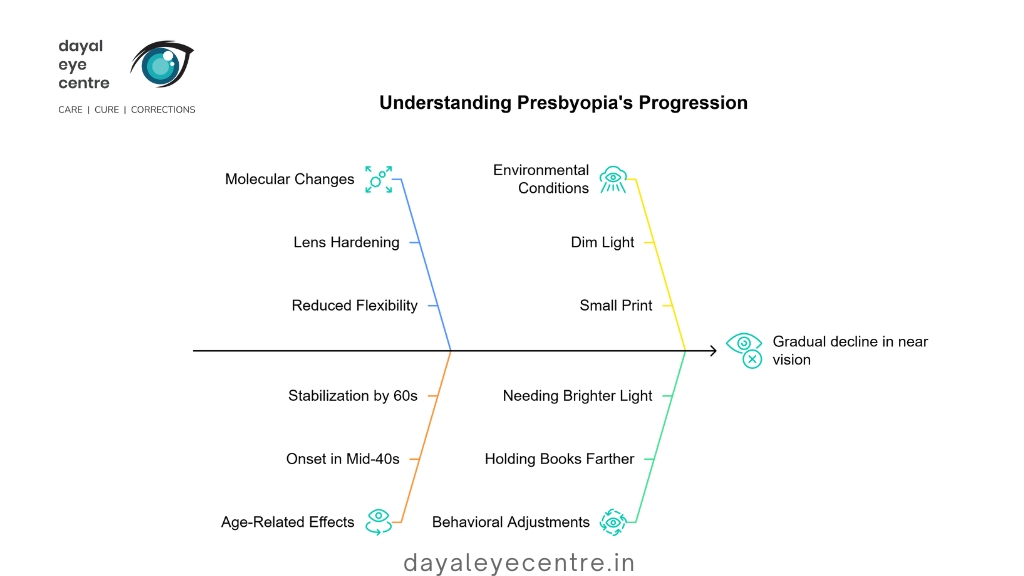
Presbyopia vs. other vision problems
Presbyopia shares symptoms with other vision conditions but remains unique:
- Presbyopia vs. Farsightedness (Hyperopia): Both make it hard to see things up close. Farsightedness happens because the eye is too short or the cornea is too flat, which makes light focus behind the retina. Presbyopia results from the lens hardening with age. Farsightedness can affect anyone, including babies, while presbyopia only affects people over 40.
- Presbyopia vs. Nearsightedness (Myopia): Naturally nearsighted people might notice presbyopia’s effects later because their eyes already focus well on close objects without much lens accommodation.
You can have presbyopia along with other vision conditions. People with farsightedness notice presbyopia symptoms sooner since their eyes already struggle with close-up vision.
Presbyopia affects everyone eventually and can’t be prevented. All the same, reading glasses, bifocals, and specialty contact lenses work well to manage this condition and help maintain clear vision.
Common Symptoms to Watch For
You can save yourself a lot of frustration by spotting presbyopia signs early. People usually start to notice these warning signs in their early to mid-40s. The condition gets worse gradually until about age 65.
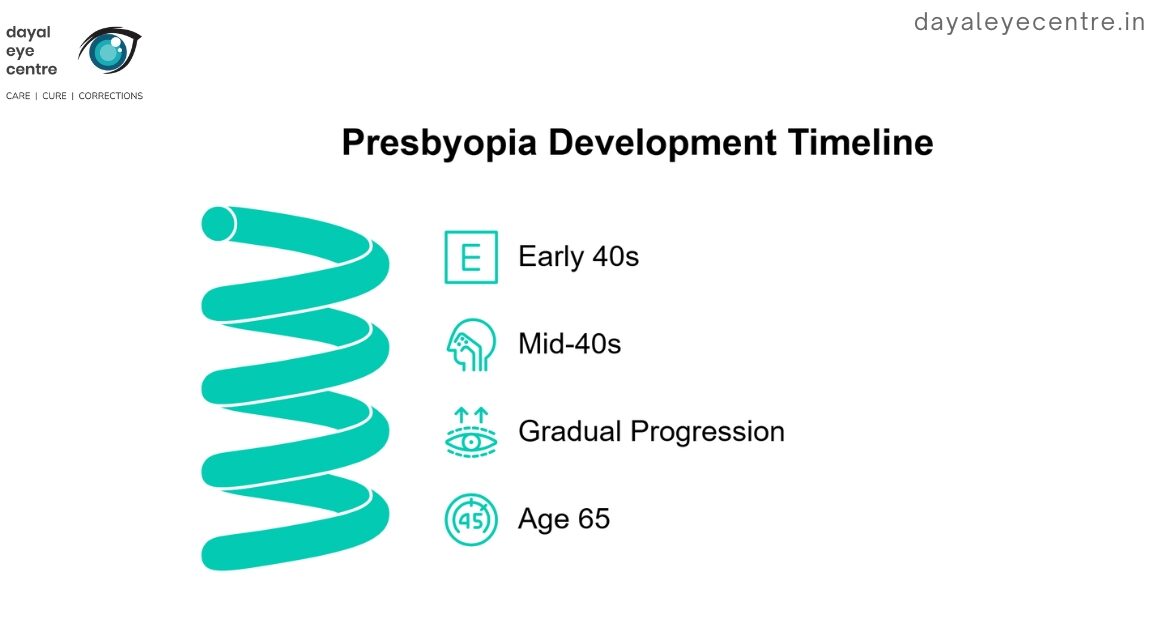
Blurry vision when reading
Blurred vision with close objects is the main sign of presbyopia. Books, smartphones, and other reading materials that were once clear become hard to see. Text that used to be sharp now looks fuzzy or out of focus. The blurriness gets worse when you’re tired or stressed, especially after a long day.
Your hardened lens can’t curve properly to focus light on your retina, which causes the blurriness. Light focuses behind your retina instead of on it, making images unclear. The blurriness gets worse in dim light, which makes reading in bed especially hard.
Eye strain and headaches
Your ciliary muscles work extra hard as your eyes struggle with close objects. This creates a lot of strain that can affect your daily life.
Eye fatigue usually shows up first – your eyes feel tired after reading or doing close work. This tiredness often leads to real discomfort around your eyes. Many people with presbyopia rub their eyes often or squint to see better.
Headaches are the sort of thing that can really disrupt your day. These happen because your eye muscles keep trying to reshape the stiff lens. People often get these headaches after they spend time reading, using computers, or doing detailed work like sewing.
Holding reading material farther away
The “trombone effect” is a telltale sign of developing presbyopia. You stretch your arms out more and more to focus on what you’re reading. Restaurant menus and text messages become easier to read at arm’s length.
Your eyes naturally look for the sweet spot where they can focus better. Your arms can only stretch so far though! Objects also look smaller at a distance, which creates another problem.
People often decide to get help with their vision changes after friends or family point out this arm-stretching habit.
Needing brighter light for close work
Do you find yourself switching on extra lamps to read? People with developing presbyopia need a lot more light to see clearly up close. Bright light makes your pupils smaller, which changes how light hits your retina and helps you see better temporarily.
You might catch yourself looking for better lighting when:
- Reading books or newspapers
- Working on crafts or detailed hobbies
- Checking small print on labels
- Using electronic devices in dim light
These symptoms create a pattern that sets presbyopia apart from other vision problems. Getting help from an eye care professional early ensures this natural aging process won’t affect your quality of life too much.
What Causes Presbyopia?
Your eyes’ ability to focus on nearby objects doesn’t just fade away – physical changes in your eyes cause this natural aging process. These changes affect how your eyes focus and reshape the scene of your vision, especially when you have changes in the lens and surrounding muscles.
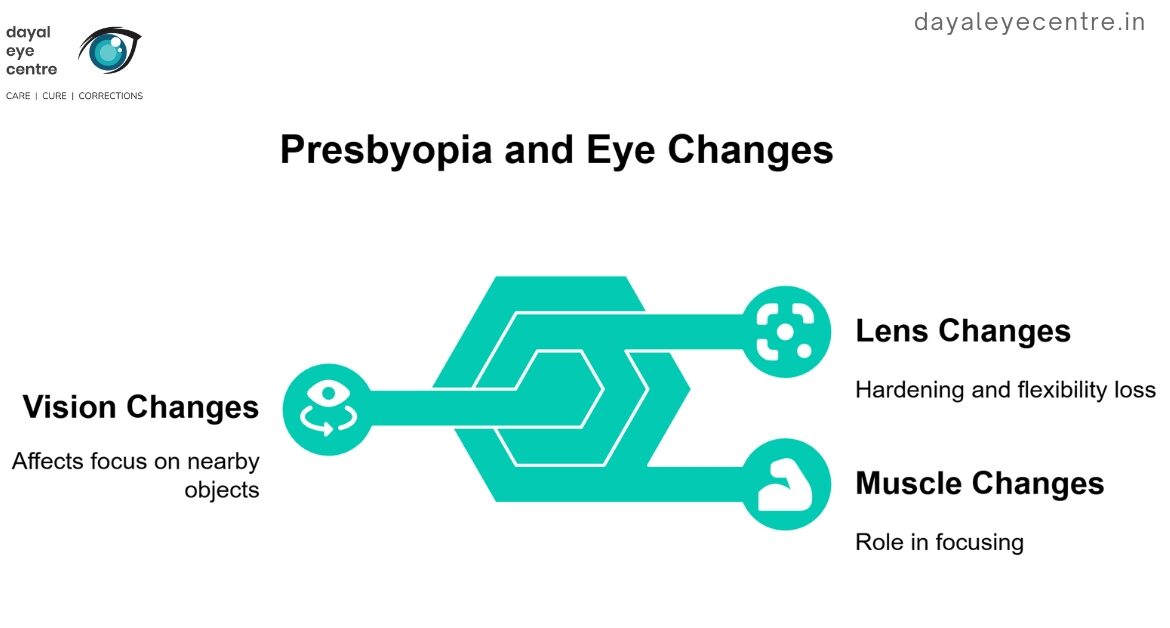
Aging and lens hardening
Presbyopia starts with a basic change in your eyes – the lens gets harder and loses flexibility over time. This process starts early but you won’t notice vision problems until your 40s. Scientists found that proteins in the lens change. The amount of alpha-crystallin (a protein that guides other proteins) decreases in the lens center as you age.
The decrease in alpha-crystallin makes it combine with larger protein groups, which makes the lens stiffer. This speeds up after middle age once the center of the lens runs out of free alpha-crystallin. This protein change explains why everyone develops presbyopia by age 45.
Loss of lens flexibility
Your lens flexibility decreases in a predictable way throughout life. Research shows focusing power drops from about 20 diopters in childhood (knowing how to focus at 50mm away) to 10 diopters by age 25. By age 60, it drops to just 0.5 to 1 diopter.
The lens stiffness changes differently in various parts. Young people’s outer layer (cortex) is stiffer than the center (nucleus). In spite of that, both parts become rigid as time passes, but at different speeds. The center and outer layer become equally stiff at age 45. After this, the center gets stiffer than the outer layer – right when reading becomes difficult.
The lens keeps growing throughout your life. New cells form at the edges constantly, creating layers like an onion. This growth increases the lens size and thickness as you age.
Role of ciliary muscles
The ciliary muscle is a vital part of the presbyopia process. This circular muscle controls your lens shape by adjusting tension on small fibers (zonules) connected to the lens. The muscle contracts to relax these fibers, which lets the lens curve and thicken to focus on close objects.
Research shows the ciliary muscle stays strong even as you age. The biggest problem isn’t weak muscles but their reduced power to change the hardened lens shape. Yes, it is true – ultrasound and MRI scans show ciliary muscle activity continues even in people with presbyopia.
Scientists have different theories about how the ciliary muscle affects presbyopia. Helmholtz’s theory says muscle contraction relaxes zonules to increase lens curve. Schachar’s theory suggests the muscle increases tension on some zonular fibers while relaxing others. Whatever theory proves right, the result stays the same – your focusing power decreases as your lens ages and hardens.
How Presbyopia is Diagnosed
Eye care professionals have refined their process to diagnose presbyopia over several decades. The process is straightforward. You might have presbyopia if you hold reading materials at arm’s length or struggle with eye strain. A complete eye examination can confirm this condition.
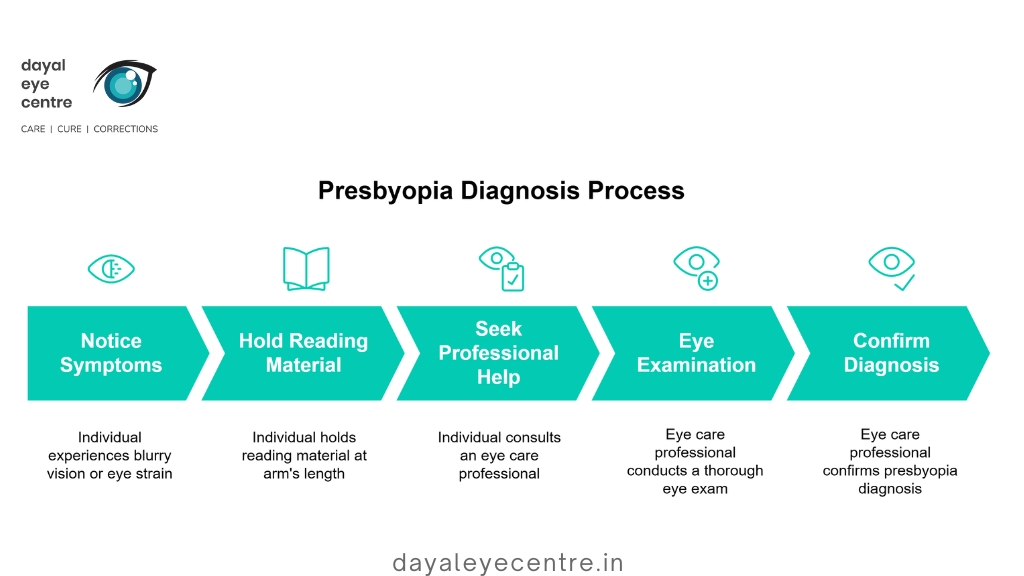
Eye exam and refraction test
The diagnosis of presbyopia starts with a simple eye exam that has two critical parts: a refraction assessment and an eye health examination. Your eye doctor will determine if you have presbyopia or other vision problems like nearsightedness, farsightedness, or astigmatism during the refraction assessment.
Your doctor will ask you to look through different lenses and tell which ones give you the clearest vision for both distant and close-up objects. We used the refraction test to detect refractive errors, including presbyopia. You’ll sit in a special chair with an attached refractor device and look at an eye chart about 20 feet away during this examination.
Tools used by eye doctors
Eye doctors use several specialized instruments to diagnose presbyopia completely. They start by checking your visual acuity with standardized charts like the Sloan chart, LogMAR, or contrast sensitivity chart. An auto-refractor helps them get preliminary measurements of your refractive status.
The slit-lamp biomicroscope stands out as the most important diagnostic tool. This device lets doctors get into the front structures of your eye under magnification. Your doctor will put drops in your eyes to dilate your pupils. This makes them more sensitive to light temporarily but gives a clearer view of your eye’s internal structures. The doctor might also use Volk lenses with the slit-lamp to get a full picture.
When to get checked
The American Academy of Ophthalmology recommends this schedule for eye examinations:
- Every 5-10 years for adults under 40
- Every 2-4 years for those aged 40-54
- Every 1-3 years for adults aged 55-64
- Every 1-2 years for those 65 and older
You might need more frequent check-ups if you have risk factors for eye disease or wear glasses or contact lenses. Regular eye examinations become crucial as we approach our 40s—the time when presbyopia typically appears—to maintain optimal vision health.
Treatment Options Explained
Managing presbyopia doesn’t have to be complicated. book an appointment eye doctor can suggest the best approach based on your lifestyle and visual needs, ranging from simple non-surgical options to advanced procedures.

Reading glasses and bifocals
Reading glasses provide a simple fix for presbyopia. You can choose between custom prescription lenses or ready-made ones that range from +1.00 to +3.00 diopters. Bifocals work well for people who already have vision problems. They combine two prescriptions in one lens – the top part helps you see far away while the bottom helps with close-up vision. Progressive addition lenses (PALs) give you smooth vision at all distances without the visible line you’d see in regular bifocals.
Contact lenses: monovision and multifocal
Contact lens options have grown by a lot. Multifocal contacts work like progressive eyeglasses, with zones for near, middle, and far vision. Monovision takes a different approach. Your dominant eye gets a lens for distance vision, and your other eye focuses on close-up tasks. Research shows success rates for monovision between 73% and 92.6%. Your success depends on how well your brain handles different focus levels between eyes and if the prescription difference stays under 2.50 diopters.
Surgical options: LASIK, lens implants
Surgery offers long-term solutions. Monovision LASIK tweaks each eye differently – one for distance, one for close-up vision. PresbyLASIK reshapes your cornea to help you focus on both near and far objects. Refractive lens exchange (RLE) swaps your natural lens with an artificial one before cataracts develop, which might free you from reading glasses. Corneal inlays boost your focus range by placing a tiny lens in your cornea.
New treatments: eye drops and brain training
Eye care keeps evolving. The Drug Controller General of India approved PresVu eye drops that boost near vision in just 15 minutes. The FDA gave their thumbs-up to pilocarpine eye drops (Vuity) in 2021. These drops work by making your pupil smaller to reduce scattered light. RevitalVision offers a groundbreaking approach through “brain training.” This software program runs for 30 sessions over two months and helps your brain process visual information better.
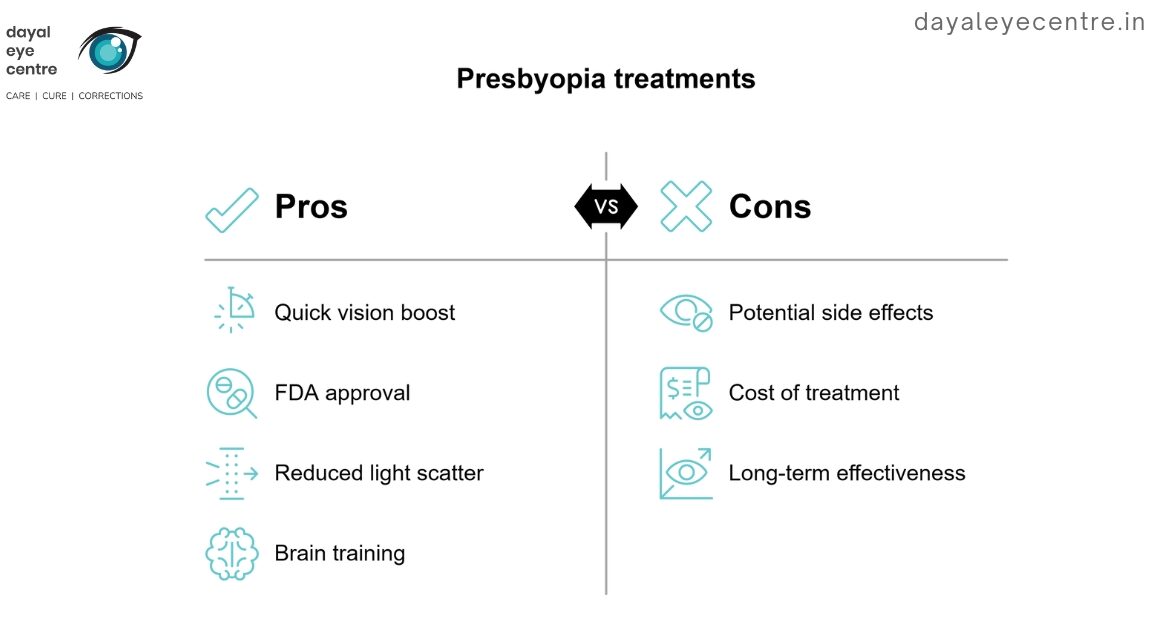
Conclusion
Learning about presbyopia helps you manage this natural part of aging vision better. This piece explores how our eye’s lenses naturally become harder as we age, usually starting between ages 40-45. The common signs include holding books at arm’s length, dealing with eye strain and headaches, and needing more light to read.
Many solutions exist to help you deal with presbyopia effectively. Simple reading glasses and bifocals work well, and specialized contact lenses like monovision options can meet different needs. Technology keeps advancing too, bringing new surgical procedures and prescription eye drops to curb presbyopia’s effects.
Eye examinations become more vital as you age. Getting complete eye exams every 1-3 years after 40 ensures proper diagnosis at the right time. Presbyopia affects everyone at some point, but its effect on daily activities stays minimal with proper diagnosis and the right vision correction.
Presbyopia naturally occurs as we age – it’s not a disease. This difference matters because while we can’t prevent it, we can adapt well with proper tools and understanding. Over the last several years, proper care and various correction options have made living with presbyopia much easier. Your quality of life and visual comfort need not suffer substantially.
FAQs
At what age does presbyopia typically start to develop?
Presbyopia usually begins to develop around age 40-45. Most people start noticing symptoms like difficulty reading small print or needing to hold things farther away to see them clearly during this time.
Can presbyopia be prevented or cured?
Presbyopia cannot be prevented or cured as it’s a natural part of the aging process. However, its effects can be effectively managed through various correction methods like reading glasses, contact lenses, or surgical procedures.
How is presbyopia different from farsightedness?
While both conditions make it difficult to see things up close, presbyopia results from age-related lens hardening, affecting everyone over 40. Farsightedness, on the other hand, can occur at any age and is caused by the eye being too short or the cornea being too flat.
What are some innovative treatments for presbyopia?
Recent innovations include FDA-approved eye drops that improve near vision, corneal inlay procedures, and even “brain training” programs that enhance visual processing capabilities. These offer alternatives to traditional correction methods.
How often should I have my eyes checked for presbyopia?
Adults over 40 should have comprehensive eye exams every 2-4 years, increasing to every 1-3 years for those 55 and older. However, if you notice changes in your vision or have risk factors for eye disease, more frequent check-ups may be necessary.
